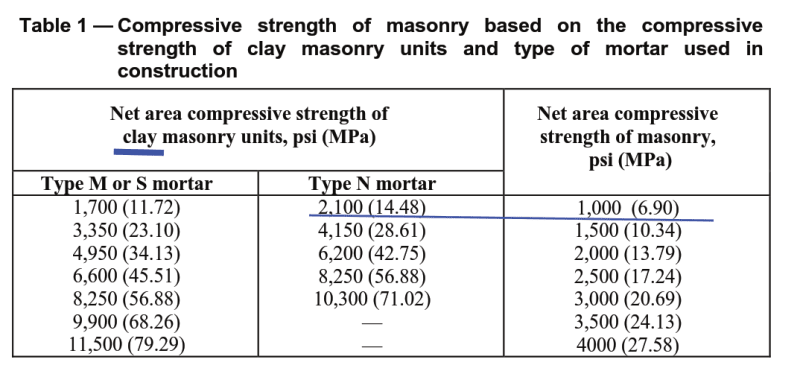We are replacing some old load bearing hollow clay tile walls with new HCT. I'm looking for any general feedback to my approach and what you would specify for mortar and grout.
The walls will have some reinforcement in them at jambs and my plan is to use new reinforced HCT lintels (I'm not a fan of steel lintels, but maybe someone can convince me otherwise).
The new HCT has a compressive strength of 2,970psi. My plan is to use the TMS 402 Unit strength method Table for clay masonry and design as I would for any other CMU (while using the E for clay).
Regarding the existing tile and mortar/grout specifications:
It seems that the "Bible" for HCT is Principles of Tile Engineering - Handbook of Design by Harry C. Plummmer and Wanner 1947 (there is also a 1950 copy, but I'm told 1947 is better). In here they have Mortar A, B, and C. It seems that type B would be commonly used for exterior wall above grade and is most similar to current type N mortar. Type B strength was a minimum of 600psi and Type N is 750psi. Therefore, I'm inclined to use type N. Which means I could use an f'm just above 1,000 psi.
ASTM476 specifies grout to be a minimum of 2,000psi. Based on some talks with the HCT supplier I get the feeling that if the grout is too strong that is a bad thing. Is this feeling justified? Would it be 'strange / reasonable' to put a maximum strength on the grout?

Any issues or recommendations?
The walls will have some reinforcement in them at jambs and my plan is to use new reinforced HCT lintels (I'm not a fan of steel lintels, but maybe someone can convince me otherwise).
The new HCT has a compressive strength of 2,970psi. My plan is to use the TMS 402 Unit strength method Table for clay masonry and design as I would for any other CMU (while using the E for clay).
Regarding the existing tile and mortar/grout specifications:
It seems that the "Bible" for HCT is Principles of Tile Engineering - Handbook of Design by Harry C. Plummmer and Wanner 1947 (there is also a 1950 copy, but I'm told 1947 is better). In here they have Mortar A, B, and C. It seems that type B would be commonly used for exterior wall above grade and is most similar to current type N mortar. Type B strength was a minimum of 600psi and Type N is 750psi. Therefore, I'm inclined to use type N. Which means I could use an f'm just above 1,000 psi.
ASTM476 specifies grout to be a minimum of 2,000psi. Based on some talks with the HCT supplier I get the feeling that if the grout is too strong that is a bad thing. Is this feeling justified? Would it be 'strange / reasonable' to put a maximum strength on the grout?

Any issues or recommendations?
